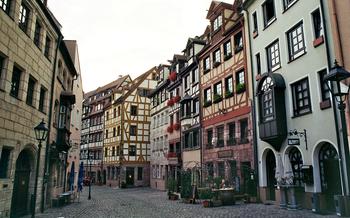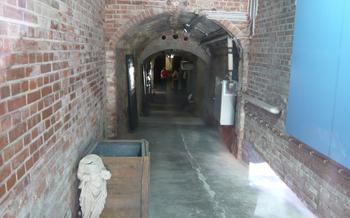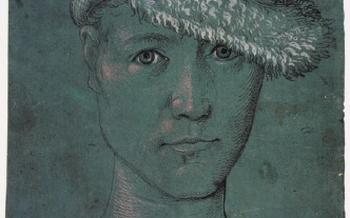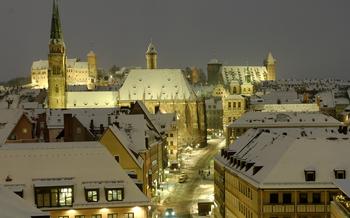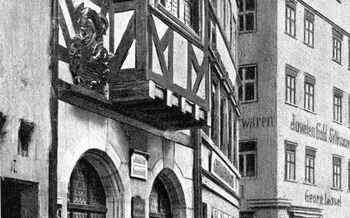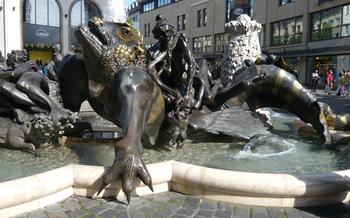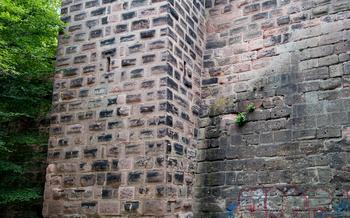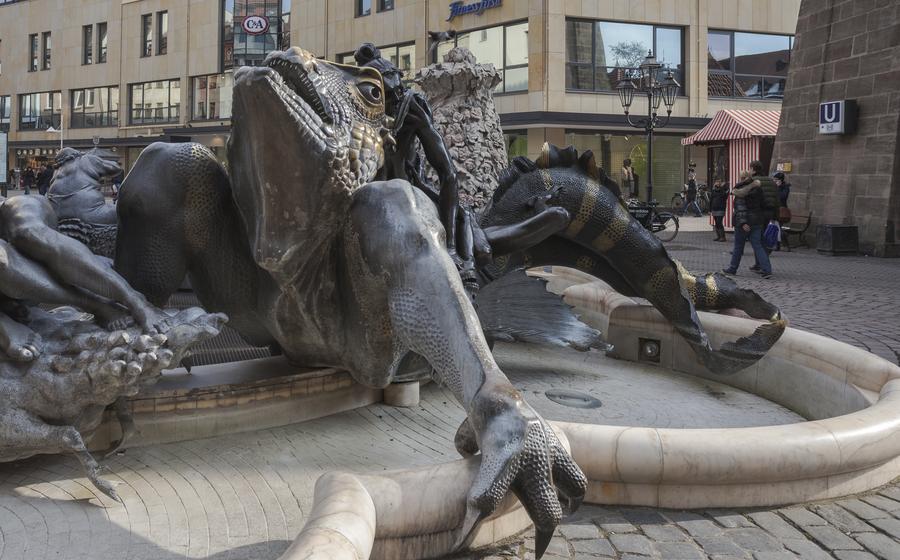
Nürnberger Felsengänge (Historical Rock Cut Cellars)
- Nuremberg’s Historical Rock-Cut Cellars
- The Network of Tunnels
- How to Get There
- Guided Tours
- What to Expect
- Highlights of the Tour
- History of the Cellars
- Exhibitions and Displays
- Nuremberg’s Underground World
- Food and Drinks
- Souvenirs and Gifts
- Other Things to Do In Nuremberg
- Insider Tip
Nuremberg’s Historical Rock-Cut Cellars
In the heart of Nuremberg, beneath the bustling streets and charming medieval buildings, lies a hidden treasure—the Nürnberger Felsengänge, a labyrinthine network of historical rock-cut cellars. These subterranean passageways, carved into the sandstone bedrock centuries ago, offer a glimpse into the city's rich past and intriguing underworld.
The history of the Nürnberger Felsengänge dates back to the Middle Ages, when the city of Nuremberg was a thriving trade center. As the city grew and prospered, the need for storage space increased, leading to the creation of these underground cellars. Over time, the cellars were expanded and interconnected, forming a vast network of tunnels that erstreched for kilometers beneath the city.
The cellars were primarily used for storing beer, wine, and other perishable goods. The constant temperature and humidity inside the tunnels provided an ideal environment for preserving these items. Additionally, the cellars were used as shelters during times of war and unrest, offering protection from invading armies and marauding bands.
The construction of the rock cellars was a remarkable feat of engineering for the time. Using only hand tools and rudimentary techniques, skilled craftsmen carved out these intricate passageways from the solid rock. The walls of the cellars are adorned with chisel marks and inscriptions, providing a glimpse into the arduous labor that went into their creation.
The Network of Tunnels
The Nürnberger Felsengänge is a vast and awe-inspiring network of tunnels that stretches for over 25 kilometers beneath the city of Nuremberg. These tunnels, carved out of solid rock, are a testament to the city's rich history and resilience.
The total number of passageways in the network is estimated to be over 200, creating a labyrinthine underworld that is both fascinating and eerie. The tunnels vary in length, with some stretching for hundreds of meters, while others are shorter and more confined.
The depth of the tunnels ranges from a few meters below the surface to over 20 meters in some sections. This variation in depth creates a sense of verticality and adds to the overall complexity of the network.
The width of the tunnels also varies, with some being wide enough to accommodate large groups of people, while others are narrow and claustrophobic. This variation in width adds to the diversity of the experience and makes exploring the tunnels a truly unique adventure.
How to Get There
The Nürnberger Felsengänge are conveniently located within walking distance from the city center. If you prefer to take public transport, the closest tram stop is "Tiergärtnertor" (lines 4 and 6) or "Dürerstraße" (lines 4 and 9).
Several parking options are available in the vicinity, including the "Parkhaus Tiergärtnertor" (located directly next to the rock-cut cellars) and the "Parkhaus Lorenzkirche" (a short walk away).
For those arriving by car, the address for GPS navigation is "Untere Schmiedgasse 52, 90403 Nuremberg."
If you enjoy a leisurely stroll, you can walk to the rock-cut cellars from the city center in approximately 15 minutes. Head towards the Lorenzkirche and continue on Karolinenstraße. Turn right onto Untere Schmiedgasse, and you will find the entrance to the Nürnberger Felsengänge on your left.
Guided Tours
The Nürnberger Felsengänge offers guided tours in German and English, providing visitors with an immersive and informative experience. Tours are available throughout the day, with the first tour starting at 10:00 AM and the last tour departing at 4:00 PM. The guided tours typically last for about 45 minutes, taking visitors through the most impressive sections of the tunnels and sharing fascinating stories about their history and significance.
The cost of the guided tours is €8 for adults, €6 for students and seniors, and €4 for children between the ages of 6 and Family tickets are also available for €20. Advance booking is recommended, especially during peak tourist season, to avoid disappointment and secure your preferred tour time.
What to Expect
A visit to the Nürnberger Felsengänge promises a unique and memorable experience. As you descend into the subterranean labyrinth, you'll be enveloped in a cool and humid atmosphere, a stark contrast to the bustling city above. The temperature inside the tunnels remains a constant 12°C (54°F) throughout the year, making it a welcome respite from the summer heat or a cozy retreat during the winter months.
While exploring the cellars, comfortable clothing and sturdy footwear are recommended. The uneven surfaces and narrow passageways require careful navigation, and good traction is essential to avoid slips or falls. Visitors should also be prepared for a bit of a workout, as the tour involves climbing stairs and navigating through tight spaces.
Accessibility for people with disabilities is limited due to the historical nature of the site. The tunnels are not wheelchair accessible, and there are several steep staircases to navigate. However, the ground-level entrance and some of the wider passageways can be explored with assistance.
Safety precautions are in place to ensure a safe and enjoyable experience for all visitors. The tunnels are well-lit, and there are handrails along the staircases. Visitors are advised to stay on the marked paths and avoid touching the rock walls, as they may be unstable.
Highlights of the Tour
The guided tour of the Nürnberger Felsengänge takes visitors through a labyrinth of subterranean passageways, revealing the unique features and historical significance of these rock-cut cellars. One of the most impressive sights is the "Große Halle" (Great Hall), a vast chamber that was once used for storage and gatherings. Its towering walls, hewn from solid rock, create an awe-inspiring atmosphere that transports visitors back in time.
Another highlight is the "Tiefer Brunnen" (Deep Well), a well that was dug more than 20 meters deep to provide water for the city's inhabitants. Visitors can marvel at the ingenuity of the medieval builders who created this essential water source.
Throughout the tour, visitors will encounter a variety of historical artifacts, including tools, pottery, and weapons that provide a glimpse into the daily lives of the people who used these cellars centuries ago. The tour also sheds light on the role that the cellars played during World War II, when they served as air raid shelters for the city's population.
The Nürnberger Felsengänge offer a unique opportunity to explore the hidden depths of Nuremberg and gain insights into its rich history. With its fascinating blend of historical significance, architectural wonders, and eerie charm, this underground attraction is a must-see for anyone visiting the city.
History of the Cellars
The Nürnberger Felsengänge were initially utilized as storage spaces for beer and wine. During the 14th century, when the city's population surged, the cellars transformed into workshops and living quarters due to the city's acute housing shortage. Craftsmen, such as blacksmiths, tanners, and cobblers, took up residence in these subterranean chambers. The network of tunnels also served as a refuge during the many wars and conflicts that plagued the region. During World War II, the cellars provided shelter to the city's residents during air raids, as they offered protection from bombs. Following the war, the cellars were neglected and fell into disrepair. However, in the 1990s, a restoration project was undertaken, and the cellars were reopened to the public as a tourist attraction. Today, they stand as a fascinating testament to the ingenuity and resilience of the people of Nuremberg.
Exhibitions and Displays
A visit to the Nürnberger Felsengänge offers not only a fascinating journey through history but also a chance to explore various exhibitions and displays. These exhibits provide in-depth insights into the cellars' rich past and showcase their unique features.
Permanent exhibitions delve into the history of the rock-cut cellars, highlighting their original purpose, use during World War II, and post-war significance. Informative panels, artifacts, and multimedia presentations bring the cellars' story to life, allowing visitors to gain a deeper understanding of their importance.
Temporary exhibitions and events add variety to the visitor experience. These rotating displays often focus on specific themes related to the cellars or Nuremberg's history. Visitors can explore topics such as medieval craftsmanship, local legends, or the city's role in World War II.
Interactive displays and multimedia presentations engage visitors of all ages. Touchscreens, interactive maps, and audio-visual presentations provide a dynamic and immersive way to learn about the cellars' history and significance.
Educational programs for children are also available, making the Nürnberger Felsengänge a great destination for families. These programs use hands-on activities, storytelling, and interactive displays to teach children about the cellars' history and the importance of preserving cultural heritage.
Nuremberg’s Underground World
Nuremberg's rock-cut cellars are not the only underground attraction in the city. There are several other fascinating sites that offer a glimpse into the city's rich history and unique geology.
One of the most popular underground attractions is the Nuremberg Dungeons, which is located in the heart of the city. The dungeons were originally built in the 13th century and were used to house prisoners during the Middle Ages. Today, the dungeons are open to the public and offer a variety of tours and exhibits that tell the story of the prisoners who were held there.
Another popular underground attraction is the Nuremberg Sewers, which are located beneath the city's streets. The sewers were built in the 16th century and are still in use today. Visitors can take a guided tour of the sewers and learn about their history and operation.
Finally, Nuremberg is also home to a number of abandoned underground tunnels that were built during World War II. These tunnels were used to protect the city's population from air raids, and some of them are still accessible today. Visitors can explore these tunnels on their own or with a guided tour.
Nuremberg's underground world is a fascinating and unique place to visit. It offers a glimpse into the city's rich history and culture, and it is sure to leave visitors with a lasting impression.
Food and Drinks
After exploring the cool depths of the rock-cut cellars, you may find yourself in need of some sustenance. Luckily, there are plenty of options for food and drinks in the vicinity. For a quick bite, head to one of the many cafes or bakeries in the area. You can grab a sandwich, a pastry, or a cup of coffee to refuel before continuing your explorations.
If you're looking for a more substantial meal, there are several restaurants nearby that serve traditional Franconian cuisine. Be sure to try some of the local specialties, such as Nuremberg sausages, Schäufele (roasted pork shoulder), or potato dumplings. For a truly authentic experience, find a restaurant with a Biergarten, where you can enjoy your meal outdoors while sipping on a cold beer.
If you prefer to pack your own lunch, there are several picnic spots in the surrounding area. You can find a quiet spot along the Pegnitz River or in one of the many parks in Nuremberg. Just be sure to pack plenty of water and snacks, as there are no shops or restaurants in the immediate vicinity of the rock-cut cellars.
Souvenirs and Gifts
If you're looking for a unique souvenir to remember your visit to the Nürnberger Felsengänge, there are several places you can explore. The official gift shop at the entrance of the cellars offers a variety of items related to the history and construction of the tunnels, including books, postcards, and replicas of historical artifacts.
For a more authentic experience, head to one of the many local shops and galleries in Nuremberg's Old Town. Here, you'll find a wide selection of traditional Franconian handicrafts, such as pottery, glassware, and wood carvings. You can also find unique souvenirs inspired by the city's rich history, including replicas of medieval weapons and armor.
If you're looking for something truly special, consider commissioning a custom-made piece of jewelry or artwork from a local artisan. This is a great way to support the local community and take home a one-of-a-kind souvenir that will remind you of your time in Nuremberg.
Here are some specific recommendations for souvenirs and gifts to look for:
-
Nuremberg gingerbread: These delicious treats are a local specialty and make for a great gift for friends and family back home.
-
Franconian wine: The region around Nuremberg is known for its excellent wine production. Pick up a bottle of local wine to enjoy with your dinner or to give as a gift.
-
Traditional Franconian clothing: If you're looking for something to wear that will make you stand out, consider buying a piece of traditional Franconian clothing. These garments are often made from high-quality materials and feature intricate designs.
-
Local handicrafts: Nuremberg is home to a thriving community of artisans who create a variety of unique and beautiful handicrafts. You're sure to find something special to take home with you.
Other Things to Do In Nuremberg
Nuremberg offers a wealth of attractions beyond its historical rock-cut cellars. History buffs will appreciate a visit to the Nuremberg Castle, the Imperial Castle, and the Germanisches Nationalmuseum, which houses an extensive collection of German art and cultural history. For a glimpse into the city's medieval past, wander through the charming Alstadt (Old Town), with its cobblestone streets, half-timbered houses, and historic churches.
Art enthusiasts won't want to miss the Nürnbergisches Kunsthaus, which showcases contemporary and modern art, or the Neues Museum, which focuses on international contemporary art. For a unique perspective on the city, take a walk along the Pegnitz River, which winds its way through the heart of Nuremberg. Along the riverbanks, you'll find picturesque bridges, tranquil parks, and a variety of restaurants and cafes.
If you're traveling with children, be sure to visit the Nuremberg Zoo, home to over 3,000 animals from all over the world. The zoo is known for its conservation efforts and educational programs, making it a great place to learn about wildlife and the environment. For a fun and interactive experience, head to the Playmobil FunPark, where kids can explore a world of imaginative play and creativity.
Nuremberg is also an excellent base for exploring the surrounding region. Take a day trip to the Romantic Road, a scenic route that winds through charming villages, medieval castles, and breathtaking landscapes. Or visit the Franconian Switzerland, a region known for its stunning rock formations, caves, and hiking trails.
Whether you're interested in history, art, nature, or family-friendly fun, Nuremberg has something to offer everyone. With its rich cultural heritage and diverse attractions, this vibrant city is sure to captivate and inspire visitors of all ages.
Insider Tip
A unique way to explore the rock-cut cellars is to join a night-time tour. The darkness adds an eerie atmosphere and gives you a chance to see the cellars in a different light. Keep your eyes peeled for the resident ghosts who are said to haunt the tunnels.
Another secret spot within the cellars is the "Tiefer Brunnen" (Deep Well). This well is over 50 meters deep and was used to store beer during the Middle Ages. It's a fascinating sight and offers a glimpse into the history of the cellars.
For a hidden gem in the surrounding area, head to the nearby "Historischer Kunstbunker" (Historical Art Bunker). This former air-raid shelter now houses a collection of over 10,000 artworks that were saved from destruction during World War II. It's a unique and moving experience that sheds light on the city's resilience during wartime.
To explore Nuremberg like a local, take a stroll through the city's many parks and gardens. The "Stadtpark" (City Park) is a popular spot for locals to relax and enjoy the outdoors. It's also home to the "Tiergarten Nürnberg" (Nuremberg Zoo), which is a great place to see animals from all over the world.
For an off-the-beaten-path experience, visit the "Germanisches Nationalmuseum" (Germanic National Museum). This museum houses a vast collection of artifacts from German history and culture. It's a great place to learn more about the country's rich heritage.

